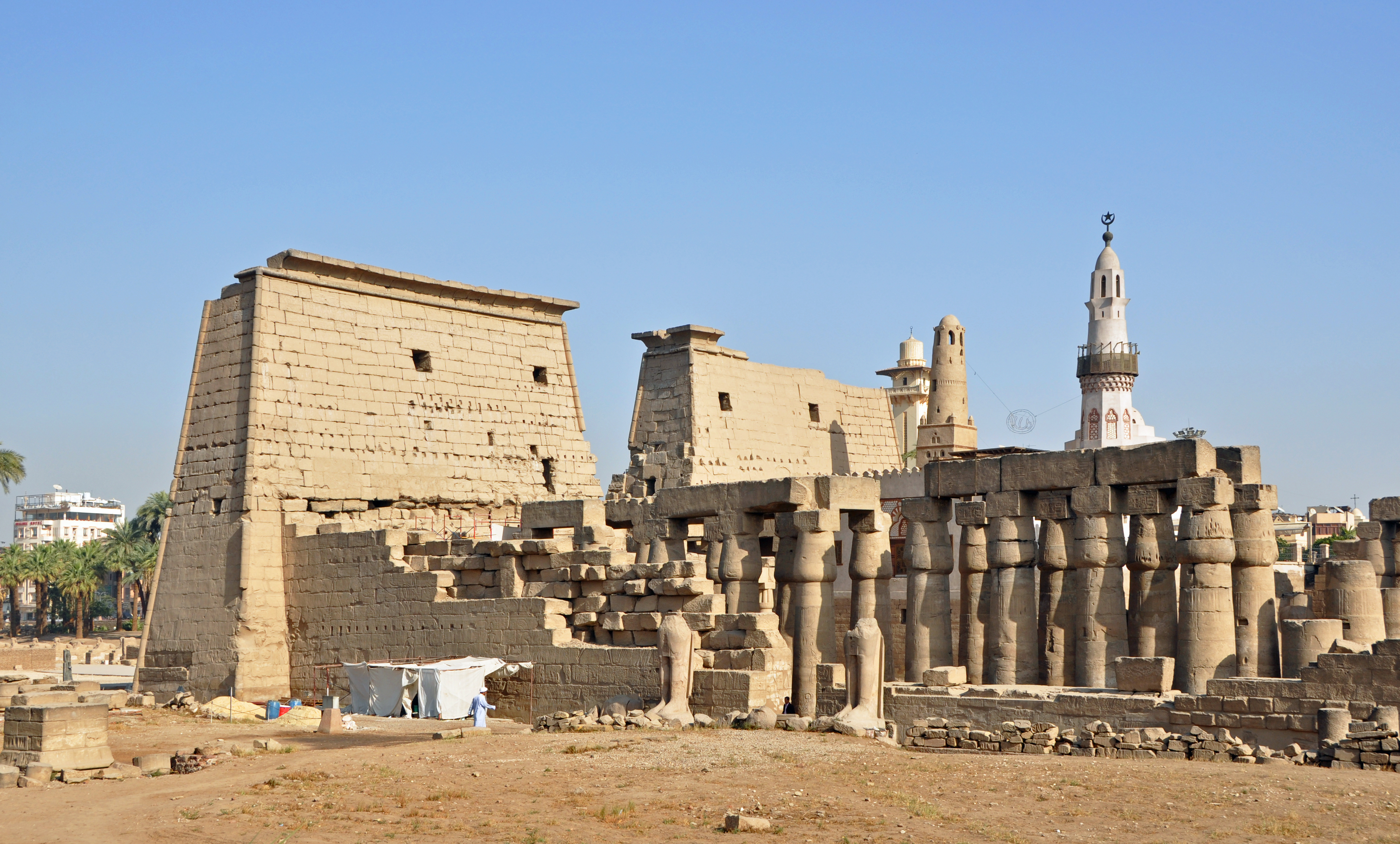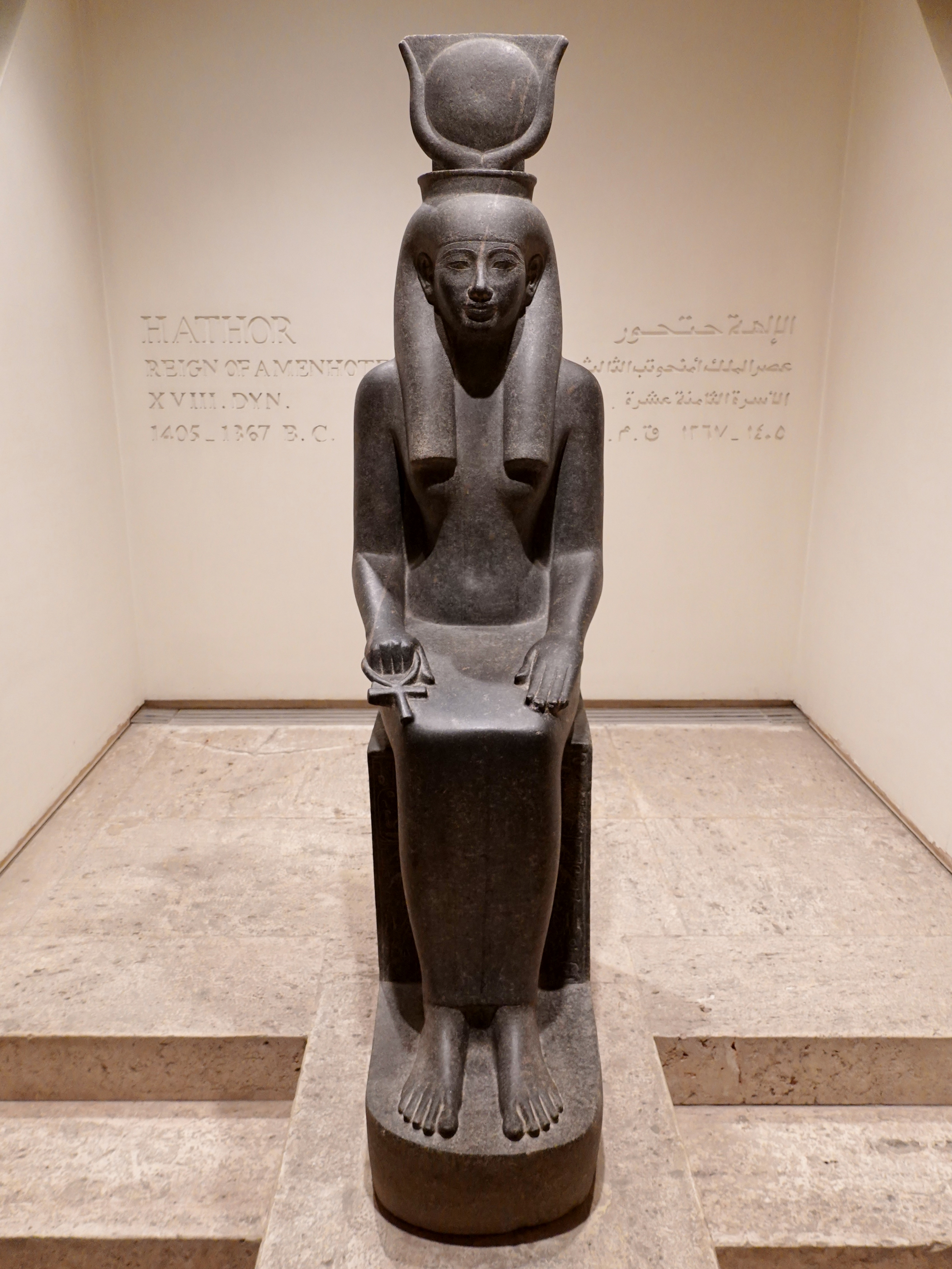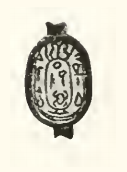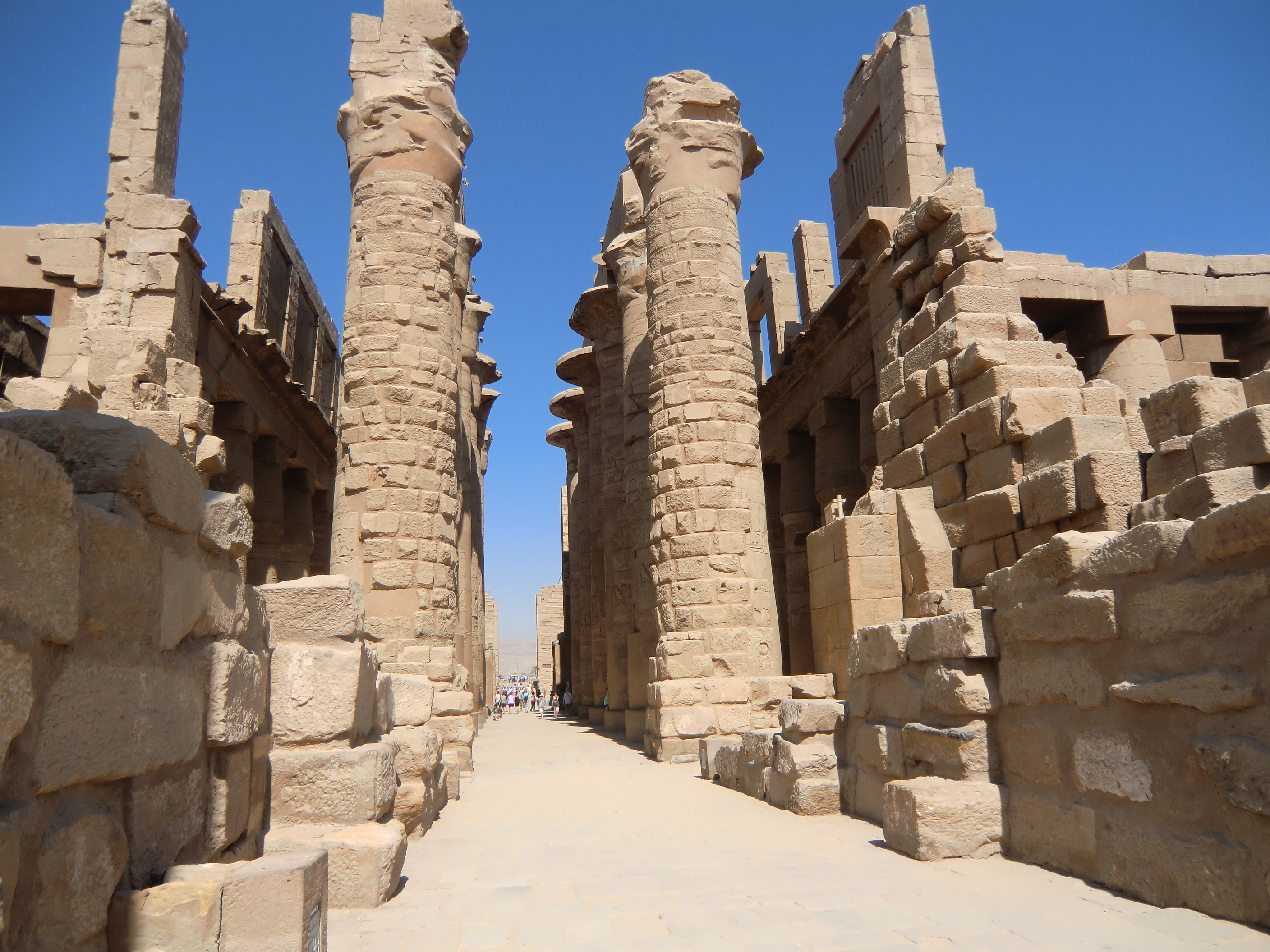|
Luxor Museum
Luxor Museum is an archaeological museum in Luxor (ancient Thebes), Egypt. It stands on the corniche, overlooking the east bank of the River Nile. Establishment The Luxor Museum was inaugurated in 1975. It is a two-story building. The range of artifacts on display is far more restricted than the country's main collections in the Egyptian Museum in Cairo; this was, however, deliberate, since the museum prides itself on the quality of the pieces it has, the uncluttered way in which they are displayed, and the clear multilingual labeling used. The museum was conceived by the Egyptian Ministry of Culture, which hired Dr. Mahmud El Hakim, a top Egyptian architect, to create the plans in 1962. The installation of the museum art works came later and was finished between 1972 and 1975. Collection Among the items on display are grave goods from the tomb of the 18th dynasty pharaoh Tutankhamun ( KV62) and a collection of 26 New Kingdom statues that were found buried in the Luxor ... [...More Info...] [...Related Items...] OR: [Wikipedia] [Google] [Baidu] |
Luxor
Luxor ( ar, الأقصر, al-ʾuqṣur, lit=the palaces) is a modern city in Upper (southern) Egypt which includes the site of the Ancient Egyptian city of ''Thebes''. Luxor has frequently been characterized as the "world's greatest open-air museum", as the ruins of the Egyptian temple complexes at Karnak and Luxor stand within the modern city. Immediately opposite, across the River Nile, lie the monuments, temples and tombs of the west bank Theban Necropolis, which includes the Valley of the Kings and Valley of the Queens. Thousands of tourists from all around the world arrive annually to visit Luxor's monuments, contributing greatly to the economy of the modern city. The population of Luxor is 422,407 (2021), with an area of approximately . It is the capital of Luxor Governorate. It is among the oldest inhabited cities in the world. Etymology The name ''Luxor'' ( ar, الأقصر, al-ʾuqṣur, lit=the palace, pronounced , , Upper Egyptian: ) derives from the Ara ... [...More Info...] [...Related Items...] OR: [Wikipedia] [Google] [Baidu] |
Luxor Statue Cache
The Luxor statue cache is a grouping of ancient Egyptian statues unearthed in 1989. They were discovered in Luxor, beneath the solar court of the 18th Dynasty Pharaoh Amenhotep III. Partial list of statues *Thutmose III as sphinx, alabaster, * Amenhotep III, standing, red quartzite, *the goddess Iunyt, seated, grey granite *Tutankhamun as sphinx, alabaster (with paint remains) *Horemheb, kneeling holding offering pots, diorite *Amun-Re-Kamutef serpent, grey granite *Amun-Re-Kamutef serpent, grey granite *Goddess Taweret, sandstone, History The excavation was launched in 1989 under the authority of Mahammed el-Saghir, with routine maintenance by the Luxor antiquities inspectorate. The Luxor cache was buried during the Roman conversion of the area into a military camp.Reeves 2000, p.226. Originally five statues were found at a three-foot depth below a covering layer of small stones; eventually 26 statues were uncovered with some being damaged prior to burial. File:GD-EG ... [...More Info...] [...Related Items...] OR: [Wikipedia] [Google] [Baidu] |
Museums Established In 1975
A museum ( ; plural museums or, rarely, musea) is a building or institution that cares for and displays a collection of artifacts and other objects of artistic, cultural, historical, or scientific importance. Many public museums make these items available for public viewing through exhibits that may be permanent or temporary. The largest museums are located in major cities throughout the world, while thousands of local museums exist in smaller cities, towns, and rural areas. Museums have varying aims, ranging from the conservation and documentation of their collection, serving researchers and specialists, to catering to the general public. The goal of serving researchers is not only scientific, but intended to serve the general public. There are many types of museums, including art museums, natural history museums, science museums, war museums, and children's museums. According to the International Council of Museums (ICOM), there are more than 55,000 museums in 202 ... [...More Info...] [...Related Items...] OR: [Wikipedia] [Google] [Baidu] |
List Of Museums Of Egyptian Antiquities
The following is a list of museums with major collections of Egyptian antiquities: Museum collections with specified number 5,000+ # Grand Egyptian Museum, Giza, Egypt: Over 100,000 artifacts (due to being partly opened in 2018, currently housed in the Egyptian Museum, Cairo) # British Museum, London, England, UK: Over 100,000 artifacts (not including the 2001 donation of the six million artifact Wendorf Collection of Egyptian and Sudanese Prehistory) # Ägyptisches Museum, Neues Museum, Berlin, Germany: About 80,000 artifacts # Petrie Museum of Egyptian Archaeology, London, England, UK: About 80,000 artifacts # Musée du Louvre, Paris, France: 77,404 artifacts # National Museum of Egyptian Civilization, Cairo Egypt: 50,000 artifacts # Boston Museum of Fine Arts, Boston, Massachusetts, USA: About 45,000 artifacts # Kelsey Museum of Archaeology, Ann Arbor, Michigan, USA: Over 45,000 artifacts # University of Pennsylvania Museum of Archaeology and Anthropology, Philadelphia, Pe ... [...More Info...] [...Related Items...] OR: [Wikipedia] [Google] [Baidu] |
Amenhotep, Son Of Hapu
Amenhotep, son of Hapu (transcribed ''jmn-ḥtp zꜣ ḥꜣp.w''; early-mid 14th century BC) was an ancient Egyptian architect, a priest, a scribe, and a public official, who held a number of offices under Amenhotep III of the 18th Dynasty. Life He is said to have been born at the end of Thutmose III's reign, in the town of Athribis (modern Banha in the north of Cairo). His father was Hapu, and his mother Itu. Though little about Amenhotep's early life is known prior to his entering civil service, it is believed that he learned to read and write at the local library and scriptorium. He was a priest and a Scribe of Recruits (organizing the labour and supplying the manpower for the Pharaoh's projects, both civilian and military). He was also an architect and supervised several building projects, among them Amenhotep III's mortuary temple at western Thebes, of which only two statues remain nowadays, known as the Colossi of Memnon, and the creation of the quarry of El-Gabal ... [...More Info...] [...Related Items...] OR: [Wikipedia] [Google] [Baidu] |
Kamose
Kamose was the last Pharaoh of the Theban Seventeenth Dynasty. He was possibly the son of Seqenenre Tao and Ahhotep I and the uncle of Ahmose I, founder of the Eighteenth Dynasty. His reign fell at the very end of the Second Intermediate Period. Kamose is usually ascribed a reign of three years (his highest attested regnal year), although some scholars now favor giving him a longer reign of approximately five years. His reign is important for the decisive military initiatives he took against the Hyksos, who had come to rule much of Ancient Egypt. His father had begun the initiatives and lost his life in battle with the Hyksos. It is thought that his mother, as regent, continued the campaigns after the death of Kamose, and that his full brother made the final conquest of them and united all of Egypt. Campaigns ''Casus Belli'' Kamose was the final king in a succession of native Egyptian kings at Thebes. Originally, the Theban Seventeenth dynasty rulers were at peace with ... [...More Info...] [...Related Items...] OR: [Wikipedia] [Google] [Baidu] |
Amenhotep III
Amenhotep III ( egy, jmn-ḥtp(.w), ''Amānəḥūtpū'' , "Amun is Satisfied"; Hellenization, Hellenized as Amenophis III), also known as Amenhotep the Magnificent or Amenhotep the Great, was the ninth pharaoh of the Eighteenth dynasty of Egypt, Eighteenth Dynasty. According to different authors, he ruled Egypt from June 1386 to 1349 BC, or from June 1388 BC to December 1351 BC/1350 BC, after his father Thutmose IV died. Amenhotep was Thutmose's son by a minor wife, Mutemwiya. His reign was a period of unprecedented prosperity and splendour, when Egypt reached the peak of its artistic and international power. When he died in the 38th or 39th year of his reign he was succeeded by his son Amenhotep IV, who later changed his name to Akhenaten. Family and early life Amenhotep was the son of Thutmose IV and his minor wife Mutemwiya. He was born probably around 1401 BC. Later in his life, Amenhotep commissioned the depiction of his divine birth to be displayed at Luxor Temple. Amenh ... [...More Info...] [...Related Items...] OR: [Wikipedia] [Google] [Baidu] |
Sobek
Sobek (also called Sebek or Sobki, cop, Ⲥⲟⲩⲕ, Souk) was an ancient Egyptian deities, ancient Egyptian deity with a complex and elastic history and nature. He is associated with the Nile crocodile or the West African crocodile and is represented either in its form or as a human with a crocodile head. Sobek was also associated with pharaonic power, fertility, and military prowess, but served additionally as a protective deity with apotropaic magic, apotropaic qualities, invoked especially for protection against the dangers presented by the Nile. Sobek has been famed for having been revered by the first female Pharaoh by the Nebty name Sat-Sekhem-Nebet-Tawy Sobekneferu, present both in the female Pharaoh's nomen, Sobek'Neferu (sbk-nfrw - Beauty of Sobek), and her praenomen Ka'Sobek'Re (The Ka of Sobek-Ra). History Sobek enjoyed a longstanding presence in the ancient Egyptian pantheon, from the Old Kingdom of Egypt (c. 2686–2181 BCE) through the Roman period (). He is f ... [...More Info...] [...Related Items...] OR: [Wikipedia] [Google] [Baidu] |
Karnak
The Karnak Temple Complex, commonly known as Karnak (, which was originally derived from ar, خورنق ''Khurnaq'' "fortified village"), comprises a vast mix of decayed temples, pylons, chapels, and other buildings near Luxor, Egypt. Construction at the complex began during the reign of Senusret I (reigned 1971–1926 BCE) in the Middle Kingdom (around 2000–1700 BCE) and continued into the Ptolemaic Kingdom (305–30 BCE), although most of the extant buildings date from the New Kingdom. The area around Karnak was the ancient Egyptian ''Ipet-isut'' ("The Most Selected of Places") and the main place of worship of the 18th Dynastic Theban Triad, with the god Amun as its head. It is part of the monumental city of Thebes, and in 1979 it was inscribed on the UNESCO World Heritage List along with the rest of the city. The Karnak complex gives its name to the nearby, and partly surrounded, modern village of El-Karnak, north of Luxor. Overview The complex is a vast open si ... [...More Info...] [...Related Items...] OR: [Wikipedia] [Google] [Baidu] |
Akhenaten
Akhenaten (pronounced ), also spelled Echnaton, Akhenaton, ( egy, ꜣḫ-n-jtn ''ʾŪḫə-nə-yātəy'', , meaning "Effective for the Aten"), was an ancient Egyptian pharaoh reigning or 1351–1334 BC, the tenth ruler of the Eighteenth Dynasty. Before the fifth year of his reign, he was known as Amenhotep IV ( egy, jmn-ḥtp, links=no, meaning " Amun is satisfied", Hellenized as ''Amenophis IV''). As a pharaoh, Akhenaten is noted for abandoning Egypt's traditional polytheism and introducing Atenism, or worship centered around Aten. The views of Egyptologists differ as to whether the religious policy was absolutely monotheistic, or whether it was monolatry, syncretistic, or henotheistic. This culture shift away from traditional religion was reversed after his death. Akhenaten's monuments were dismantled and hidden, his statues were destroyed, and his name excluded from lists of rulers compiled by later pharaohs. Traditional religious practice was gradually resto ... [...More Info...] [...Related Items...] OR: [Wikipedia] [Google] [Baidu] |
Ramesses I
Menpehtyre Ramesses I (or Ramses) was the founding pharaoh of ancient Egypt's 19th Dynasty. The dates for his short reign are not completely known but the time-line of late 1292–1290 BC is frequently cited as well as 1295–1294 BC. While Ramesses I was the founder of the 19th Dynasty, his brief reign mainly serves to mark the transition between the reign of Horemheb, who had stabilized Egypt in the late 18th Dynasty, and the rule of the powerful pharaohs of his own dynasty, in particular his son Seti I, and grandson Ramesses II. Origins Originally called Pa-ra-mes-su, Ramesses I was of non-royal birth, being born into a noble military family from the Nile Delta region, perhaps near the former Hyksos capital of Avaris. He was a son of a troop commander called Seti. His uncle Khaemwaset, an army officer, married Tamwadjesy, the matron of Tutankhamun's Harem of Amun, who was a relative of Huy, the viceroy of Kush, an important state post. This shows the high status of Ram ... [...More Info...] [...Related Items...] OR: [Wikipedia] [Google] [Baidu] |
Ahmose I
Ahmose I ( egy, jꜥḥ ms(j .w), reconstructed /ʔaʕaħ'maːsjə/ ( MK), Egyptological pronunciation ''Ahmose'', sometimes written as ''Amosis'' or ''Aahmes'', meaning " Iah (the Moon) is born") was a pharaoh and founder of the Eighteenth Dynasty of Egypt, classified as the first dynasty of the New Kingdom of Egypt, the era in which ancient Egypt achieved the peak of its power. He was a member of the Theban royal house, the son of pharaoh Seqenenre Tao and brother of the last pharaoh of the Seventeenth dynasty, Kamose. During the reign of his father or grandfather, Thebes rebelled against the Hyksos, the rulers of Lower Egypt. When he was seven years old, his father was killed, Shaw. (2000) p. 199. and he was about ten when his brother died of unknown causes after reigning only three years. Ahmose I assumed the throne after the death of his brother, Grimal. (1988) p. 192. and upon coronation became known as '' nb- pḥtj- rꜥ'' "The Lord of Strength is Ra". Durin ... [...More Info...] [...Related Items...] OR: [Wikipedia] [Google] [Baidu] |








